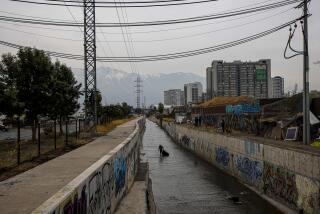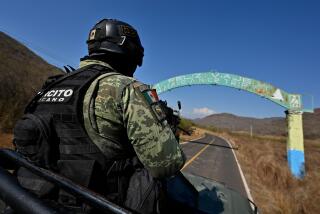Chile rejoices as all 33 miners are rescued
Reporting from Copiapo, Chile — Chile freed the last of 33 miners from imprisonment nearly half a mile underground late Wednesday, the miracle of a second chance at life made real by the methodical shuttle of a battered red, white and blue rescue capsule willed on by a joyful nation and global audience of hundreds of millions.
When 54-year-old foreman Luis Urzua emerged at 9:55 p.m. from the 28-inch-diameter hole that curved deep into the San Jose mine, it had been 69 days since the miners were trapped, 52 days since they were able to declare to the world that they were still alive — but less than 22 hours since the first miner had resurfaced.
“You brought your shift out like a good captain,” Chilean President Sebastian Pinera told Urzua, beaming as he gripped the arms of the burly miner who had organized his men for survival during the first crucial hours after they were trapped. “All of Chile shared your anguish and hope.”
The president, the foreman and rescue workers then joined in a rousing rendition of Chile’s national anthem. With all of the miners safe, jubilation also broke out in the main square of Copiapo, the state capital 40 miles from the mine and home to most of the miners. More than 3,000 people crowded the plaza to watch the final rescue on giant TV monitors.
Just a couple of hours after Urzua reached the surface, the last of six medics and engineers who had descended into the shaft to assist the miners was seen on video from below, waving and taking a bow before being lifted out. He left the lights on.
Much of the world had been transfixed by the rescue. Two thousand news reporters had crammed into the mining camp. The government used earthmovers to create parking spaces for the cars, campers and satellite trucks that converged on this desolate spot about 500 miles north of the Chilean capital, Santiago, to cover each rescue, one after the other, in what turned out to be a seamless operation captured from every angle on state television.
The first miners were pulled to safety just after midnight Tuesday, delivered into the waiting arms of ecstatic family members, engineers and officials.
“We have lived a magical night, a night we will remember throughout our lives, a night in which life defeated death,” Pinera said early Wednesday.
As daylight broke, the pace quickened — each miner’s emergence unleashing a new wave of raw emotion. What only hours earlier seemed magical, however, also became routine.
One after another, ordinary men, united in an incredible tale of survival and distinguished by each one’s unique skills and story, returned.
The 55-year-old miner who led a prayer group followed the 26-year-old former security guard who helped manage packages sent down to the miners. The one who while trapped asked his wife of 25 years to renew their wedding vows was followed by the one who went underground to pay for his son’s medical school. The miner colleagues referred to as “Dr. House” after the TV character preceded the one who monitored gas levels in the pit and sent readings to the surface.
Officials said initial indications were that the men were in remarkably good health.
Speaking to reporters Wednesday afternoon, Health Minister Jaime Manalich said that only one of the 17 miners who had reached the Copiapo Regional Hospital by that point showed any symptoms of a serious illness.
That miner, who was not identified, was suffering from pneumonia, a condition that had been diagnosed remotely while he was still underground. Doctors were prepared and had already begun to treat him, Manalich said.
Ophthalmologist Luis Salinas said that initial examinations showed no apparent eye damage from weeks of no sunlight, contrary to the fears of medical experts.
Otherwise, the miners’ health so far was “more than satisfactory,” Manalich said, adding that the first ones to be rescued would probably be discharged from the hospital starting Thursday afternoon.
He said there were tentative plans for a news conference with most, if not all, of the miners in a few days to share their experiences.
“I think it would be good for them that the entire nation sees them at the start of this new phase of life that they are starting,” Manalich said.
As the full dimension of the unprecedented accomplishment of pulling the trapped miners to safety hit home, national pride and joy swept the nation.
On a barren desert hillside a short distance from the winch that hauled the miners up, the 33 Chilean flags placed there soon after the Aug. 5 mining accident fluttered against an azure sky, transformed into symbols of nationalism by the rescue of the miners.
While his countrymen celebrated the emergence of each miner, Pinera took congratulatory calls from other heads of state. President Obama said the rescue “is a tribute not only to the determination of the rescue workers and the Chilean government, but also the unity and resolve of the Chilean people, who have inspired the world.”
Obama also singled out the Americans who manufactured and operated the drill that reached the miners, and the NASA team that helped design the rescue capsule.
Alicia Campos, whose 27-year-old son, Daniel Herrera Campos, was the 16th to be lifted out of the mine early Wednesday afternoon, said her first order of business was to take him home to southern Chile and say a Mass of thanksgiving.
Before leaving to greet her son, Campos likened the rescue to a “ cesarean section done on Mother Earth.”
“Daniel will truly be born again. But before I hug him and tell him how much I love him, I will thank God for allowing it to happen,” Campos said. Later, TV coverage of her son’s rescue showed their tearful reunion.
Kraul is a special correspondent.
More to Read
Sign up for Essential California
The most important California stories and recommendations in your inbox every morning.
You may occasionally receive promotional content from the Los Angeles Times.










